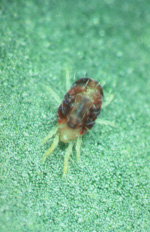Fungal pathogens of mites and ticks
The Acarina (or Acari) are a subclass of the Arachnida and are comprised of mites and ticks (other members of the arachnids are spiders and scorpions). Mites and ticks are arthropods, with jointed legs, hardened exoskeletons and specialised mouthparts. They usually have four pairs of legs although some species have fewer.
Most species of the Acarina have no detrimental impact on humans. Indeed many perform vital functions as decomposers and predators. However, there are still a large number of acarine species which have a negative impact on people, either directly or through damage to crops or livestock.
Significant crop pests occur within the Prostigmata (Actinotrichida), especially the Eriophyidae and the Tetranychidae, which are obligate plant feeders.
The Ixodida (ticks) are blood feeding ectoparasites of vertebrates, and are important pests of humans and domesticated animals. There are over 800 species of ticks. Ticks transmit diseases to humans, many as a result of zoonotic associations, and constrain livestock production.
Acarine pests of animals are also found in the Mesostigmata (Anactinotrichida). Varroa destructor is a pest of the European honey bee that has severely depleted populations of this highly beneficial insect around the world. However, this group also includes the Phytoseiidae, which are predators of phytophagous mites, and species of the genera Typhlodromus, Amblyseius and Phytoseiulus are used widely as biocontrol agents of phytophagous mites.
Traditionally, mites and ticks have been controlled with chemicals. However, the onset of pesticide resistance in some key species, and public concerns about chemical applications, are driving research into alternative, sustainable methods for their control, including biological control.
Fungi are important natural enemies of arthropods and can be used for biological control. Most attention has been given to fungal pathogens of insects, which are widespread in nature and are being exploited to control pests through introduction and augmentation. Less attention has been given to the exploitation of fungal pathogens for the control of acarine pests. There are, however, a range of fungal species which attack Acari and which can be used for biological control. There are records of around 60 species of fungi infecting over 70 species of Acari.
Most reports concern infections in the Tetranychidae and Eriophyidae. Two species of Acari-specific pathogens - Hirsutella thompsonii and Neozygites floridana - are natural regulators of eriophyoid and tetranychid mites respectively. Research has been done to understand the factors leading to epizootics of these fungi and to enhance natural pest control. Hirsutella thompsonii was also developed as the commercial product Mycar for the control of eriophyoid mites on citrus, but was withdrawn from sale in the 1980’s, despite some promising effects in the field.
Beauveria bassiana, Metarhizium anisopliae, Isaria farinsoa, Isaria fumosorosea and Lecanicillium spp. infect ticks in nature, and B. bassiana and M. anisopliae are being studied as biological control agents of cattle ticks in Africa and South America. Beauveria bassiana also has potential as a mycopesticide of the two spotted spider mite, Tetranychus urticae.
Although the study of fungal pathogens of Acari has tended to be a minor branch of invertebrate pathology, there are some good opportunities to use them for biocontrol. There is scope to develop fungal biocontrol agents against a range of acarine pests, both as stand-alone treatments and for use in integrated pest management. Further research is required to clarify the taxonomic status of fungal pathogens of Acari, to study their ecosystem function, and to develop efficient mass production systems for species of Hirsutella and Neozygites.
Selected reference:
CHANDLER, D., DAVIDSON, G., PELL, J. K., BALL, B. V., SHAW, K. V. & SUNDERLAND, K. D. (2000). Fungal biocontrol of Acari. Biocontrol Science and Technology, 10, 357-384.

Carmine mite
